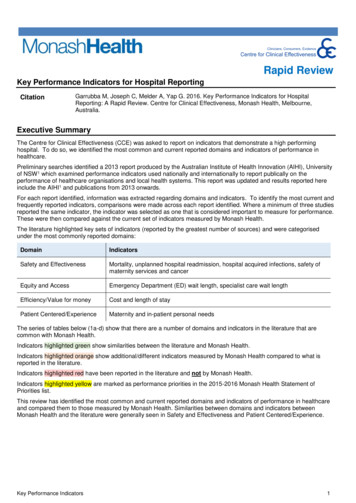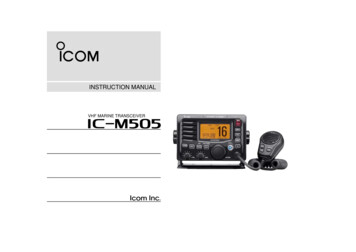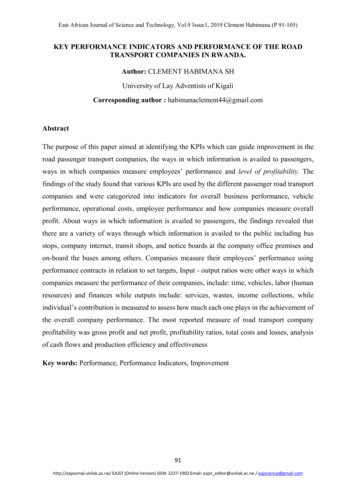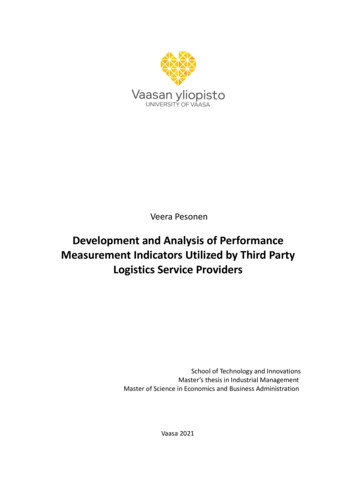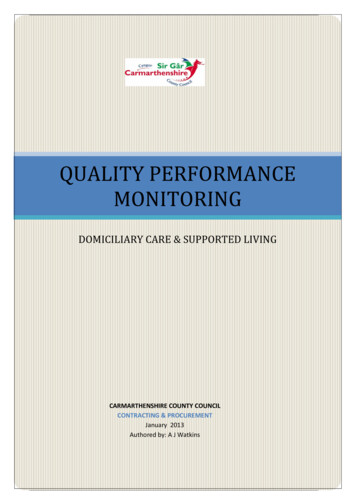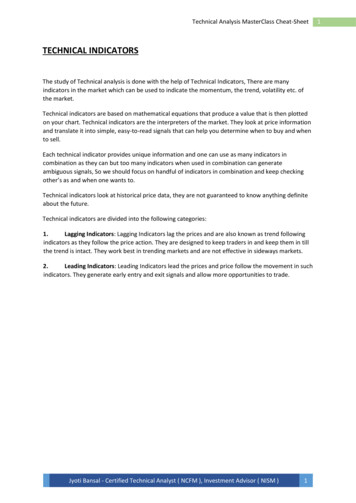
Transcription
High-TechWhite PaperUsing Channel KeyPerformance Indicatorsto Grow Channel Sales1
High-TechWhite PaperIntroductionWho are the most successful salespeople in any business-to-business channel organization? They are the “challengers,”— people who challenge the status quo and bring actionable new insights to their customers. This conclusion is basedon exhaustive research conducted by the Corporate Executive Board (CEB), an organization that helps senior executivesand their teams improve business performance.The Sales Executive Council of CEB studied thousands of sales reps across a range of industries and geographies. As aresult, they created five major “profiles,” including: Hard Workers, Relationship Builders, Challengers, Lone Wolves andReactive Problem Solvers.One might think that “Relationship Builders” would have the best sales success records. In fact, they were the leastsuccessful. Instead, the “Challenger” group dominated in today’s complex B2B selling environment. Challengersinfluenced the sales process in three ways: They brought new financial insights to the customer using an educational approach They tailored their insights to the customer’s immediate business problems They controlled all aspects of the sale from beginning to endThe details of challenger selling can be found in “The Challenger Sale” (Matthew Dixon and Brent Adamson, CEB,2011). However, our focus is to examine where the insights come from that provide the fodder for “challenger” sellingin the channel. One source for these insights are Key Performance Indicators (KPIs).What are Key Performance Indicators (KPIs)?According to Bernard Marr, a leading business and data expert, KPIs can be defined as “the most importantperformance information that enables organizations or their stakeholders to understand whether the organization is ontrack or not.”KPIs are based on the principle of “What gets measured gets managed.”KPIs don’t exist in a vacuum. They are built on business or departmental goals, and they help businesses stay onstrategy and achieve desired results. KPIs can take the form of raw numbers, progress toward a goal, or a change inpercentage. In any case, they must be quantifiable to be measured.Source and frequency are two important components of KPIs. Where does the information come from, and howfrequently can it be made available for analysis? In this regard, Channel Data Management (CDM) solutions play animportant role. CDM applications draw point-of-sale (POS), APOS, inventory and SISO data directly from channelsources at multiple tiers (distributors, resellers, etc.). And they do so in real-time, making the data instantly available forbusiness analysis.2
High-TechWhite PaperKPIs are the vital signs of a healthy businessChannel Key Performance Indicators were defined back in 2005 by two professional services firms, KPMG and EY (Ernst& Young), so that managers would know what was important to measure when growing the channel. Channel KPIs arevital to keeping a channel business or department on strategy.KPIs vary not only by business, but also by function within the business. Marketing and sales, finance, operations—eachdepartment needs a different set of channel Key Performance Indicators (KPIs) to determine how it’s performing againstestablished goals. Moreover, managers in these disciplines need an application of push notifications to alert them whenKPIs stray outside of pre-established boundaries, and reports that pop up in their work flow to let them know when thebusiness is out of sync with the business plan.Literally hundreds of KPIs can be tracked for any complex business. However, tracking everything defeats the purposeof having KPIs, especially for the channel.In the rest of this paper, we’ll examine some channel KPIs common to businesses that depend on channel sales for theirsurvival and exponential growth.Channel KPIs depend on accurate, reliable and timely informationBusinesses that operate with a multi-tier distribution model need channel KPIs that measure channel partnerperformance for each tier. This includes Tier 2 organizations executing a pull through sales strategy as well as Tier 1distributors pushing inventory daily to maximize sales. Using Alert Notifications, KPIs can be used to provide the regionor division to proactively respond before the weekly global sales meeting.Traditionally, information about what was going on downstream in the channel was hard to come by. Distributors,resellers, and other channel partners did not readily share data about sales and inventory status unless somethingwas in it for them, and now there is. A recent survey sponsored by Model N and Baptie & Company found that 75% ofreporting partners want clean channel information too, just like the manufacturer.Manufacturers who set up internal applications to gather this information are challenged to collect and integrate thedata they ask for. POS, APOS, Inventory and SISO data is often self-reported by channel partners, so its accuracy andreliability is questionable. Inaccurate data, in turn, impacts the accuracy of incentive payments. As a case in point,one customer who recently signed on with Model N discovered, after their data had been cleansed, that 7% of thetransactions on which they were paying incentives were duplicates, significantly distorting the program’s ROI.Conflicting data must be reconciled through either a manual or BPO (Business Process Outsourcing) process. POS,APOS, Inventory and SISO data (Sales In, Sales Out) data coming from different platforms must also be standardized soit can be integrated into a single, usable repository to allow for channel master data management.Once the data is cleansed to ensure its accuracy, and standardized so that apples can be distinguished from oranges, itthen needs to be analyzed and compared to whatever metrics have been established. Channel KPIs monitor all of thisat both the executive and tactical business operations level. All this effort can consume a great deal of a company’sinternal human, IT, and financial resources.3
High-TechWhite PaperFortunately for manufacturers, there are now a range of options to accomplish this task. (See illustration) With theadvent of cheaper data storage and easy-to-use analytical tools provided by third-party vendors, this herculean task isnow manageable. Manufacturers and vendors can stop worrying about the mechanics of acquiring accurate, reliableinformation from the channel. Instead, they can focus on establishing meaningful channel KPIs.Gaining insight into the channelHaving accurate, reliable information is predicated on good data collection processes. Model N’s eBook on BestPractices for Channel Data Collection points out that businesses that implement a program to obtain reliable channeldata could avoid incentive overpayments by 6%. Next in importance are dashboards with the ability to proactively notifythe CFO, Channel Chief, CMO, or CEO how the channel is performing compared to the company’s business plan. Thisdashboard functionality is accomplished through alerts, flash reports, and notifications that automatically pop up in amanager’s workflow when a KPI falls outside its set parameters. The manager can then interpret and investigate thedata to identify the source of the problem.Good data collection practices, proactive dashboards, managerial experience and sound thinking ability are theelements that provide a solid footing on which to establish, track and gain insight from channel KPIs.KPIs for Channel SalesFor companies deriving a majority of their business from the channel, gaining a handle on channel sales is critical.Yet manufacturers and vendors often struggle to know where their products are ultimately sold, to whom, andat what price.As noted previously, this challenge can be met by the use of a CDM (Channel Data Management) cloud application thatoffers channel KPIs, dashboards, alerts, flash reports, and workflow notifications about the business and the market as awhole via a back-end process that automatically collects, cleans, standardizes and enhances POS, APOS, Inventory andSISO data from multiple tiers of the channel.First, it’s important to relate channel KPIs to the company’s business plan and channel strategy, ensuring that they arewell defined, quantifiable, and consistent from year to year. It’s also important to set a threshold or benchmark for eachchannel KPI.For example, “Increased channel sales” is a poorly defined channel KPI without a target. Instead, “Grow channel salesamong our top 20 distributors by 10% by year’s end” is a more precisely defined and targeted KPI; another might bepulling 70% of sales through to the tier 2 reseller and deploying the appropriate inventory at the tier 2 level to deliver ona 20% sales growth number.Another important consideration is to understand how KPIs relate to one another. For example, sales growth is adesirable metric, but not at the expense of eroding price margins. Knowing how one KPI impacts another is required togain a big picture view of the business.Sales-related KPIs can be developed around any number of criteria, including, for example, the publishedrecommendations by KPMG, EY, and NEDA (National Electronics Distributors Association).4
High-TechWhite PaperSales GrowthSales growth tells you whether revenue is increasing or decreasing, and at what rate. This metric can be applied toindividual partners, geographic regions, individual products or services, end-customers or end-markets. Over time,trends will emerge that can provide insight for strategic decision-making.Sales per PartnerUse this metric to gauge the ability of individual partners to generate revenue for the company. Trending data can helpyou separate the good performers from the poor ones so you can take appropriate action.Sales BookingsBookings represent a commitment to buy, or a sale not yet made. This metric can help with sales forecasting. Anincrease or decrease in bookings by partner, region, end-customer, or end-market in a given time period can provideinsight into potential problems or opportunities.Average Sales Order PriceThis metric measures the average value of each purchase order processed by channel partners. Purchase ordersinclude product names, number of units, and sales price. This information can help quantify opportunities associatedwith end-customers. Combining this KPI with others such as units per transaction can offer insight into futureinventory requirements.Top Active OpportunitiesAn active opportunity is a qualified lead. Measuring the number of top active opportunities by partner helps with salesforecasting. A growth or decline in this metric also helps identify top performing partners, or points to problems thatshould be addressed.Lead to Shipped OrdersHow long does it take from the time a lead is generated until the sale is consummated and the order shipped? Thismetrics speaks to the efficiency of the sales process and the ability of the partner’s sales force to close deals.Fulfillment by Units and Dollars SoldHow efficient is the order fulfillment process? Converting orders to cash impacts not only the revenue sideof the business, but also customer satisfaction. This KPI measures how quickly, accurately, and completely ordersare processed.Canceled OrdersThis metric may point to a fall-off in demand or a problem with product quality, among other possibilities. The salesKPIs noted above represent a mere sampling of potential KPIs that could be used to gauge partner and productperformance in the channel. Which KPIs you choose to track will depend on your business model and company goals.5
High-TechWhite PaperKPIs for Channel MarketingSales incentive programs are one of the key tactics used in channel marketing. In a recent survey1, manufacturersreported running an average of 21 channel incentive programs annually, spending on average 11% of channel revenue.These programs involved incentives such as back-end rebates, revenue rebates, MDFs (Marketing Development Funds),deal registrations and co-op funds.However, manufacturers also reported having a difficult time knowing what they were getting from these programs. Forexample, only 38% of manufacturers reported that they were able to calculate ROI on their incentive spend.Following is a list of criteria that manufacturers rated as important when it comes to incentive programs: Testing and modeling before launch Immediate visibility into performance Ability to compare performance against goals Ability to identify under/over performing programs Speed of incentive paymentIn the survey, however, only 34% of respondents indicated satisfaction with their ability to meet these criteria.Manufacturers were also troubled by overpaying incentives (by an average of 6% according to this survey), and channelpartners were bothered by late payments from manufacturers.Having accurate, reliable, and timely POS information allows manufacturers to establish KPIs that address some ofthese issues and concerns. Tracking how quickly incentive payments are made to channel partners, for example, couldprovide insight into the health of the relationship with key partners. And tracking performance against establishedprogram goals could provide the insight needed to adjust program elements, or curtail or expand a program.Following are a couple of marketing-related KPIs that can help channel marketers gain insight into their strategies:Return on Investment (ROI)This KPI measures revenue generated by an incentive program (or other marketing tactics) compared to the cost ofrunning the program. The ability to gather POS data instantaneously using a CDM application allows channel marketersto assess programs midstream and make adjustments on the fly.Incremental SalesThis metric measures the contribution that an incentive program (or other marketing tactic) makes toward increasingsales. It’s a measure of net revenue increase above a benchmark, and it provides insight into the effectiveness of theprogram being measured.6
High-TechWhite PaperKPIs for Channel InventoryKeeping track of inventory and anticipating future needs is important to keep the channel pipeline running smoothly.A CDM application gives you real-time reporting on the status of your inventory. Following are some KPIs that canprovide deeper insight:Order TrackingThis indicator tracks the current status of all orders and classifies them based on criteria such as shipped, back-orderedor onhold. It provides a snapshot view of inventory in the channel at any given time.Inventory TurnoverThis KPI measures how many times a year your channel partners are able to sell their entire inventory. It’s an indicatorof channel efficiency, and also provides insight into partner performance, product quality and product mix.Back Order RateThis KPI measures orders that cannot be filled at the time of purchase. Customers who have to wait for the productsthey ordered are likely to be dissatisfied and may eventually go elsewhere. A high back order rate points to a problemwith inventory management.Again, the examples noted above simply illustrate a few of the many KPIs that could be established related to channelinventory. The key point is that a CDM application can track these metrics in real time, using clean, standardized data.This makes inventory management in the channel a whole lot easier and more efficient.KPIs for Channel FinanceIn a recent post, Bernard Marr, a noted consultant and author, described his top 25 “need to know” KPIs. He prefacedhis list by saying that these KPIs should be relevant to most companies. However, each company should develop andtrack its own industry-specific KPIs. He organized his top 25 list into four categories. Following are the KPIs he listed formeasuring and understanding financial performance: Revenue growth rate (The rate at which a company’s income is increasing) Net profit (Income minus expenses) Net profit margin (Percentage of revenue which is net profit) Gross profit margin (Percentage of revenue which is gross profit, or revenue generated for each dollar of sales) Operating profit margin (Operating income divided by revenue) Return on investment (ROI) (Revenue generated by investing into an aspect of a company’s operations, relative to thecost of that investment)Obtaining accurate and reliable information from channel partners in order to track these metrics is the real challenge.CDM software is designed to recognize revenue from channel partners as it occurs so that KPIs such as these can beused to measure a company’s performance in the channel.7
High-TechWhite PaperKPI-Based ScorecardsKPIs are key metrics providing insight into various aspects of channel business. Scorecards consolidate these metrics bybusiness function, and provide a means to evaluate channel partner performance.Why use scorecards? Because they can help you identify the channel partners who are making the greatest contributionto your business and who deserve the greatest support.Manufacturers and vendors need channel partners who are aligned with their business model, and who share theirgoals, objectives, and values. They also want partners who focus on the vertical markets and end-customers withgreatest potential to drive mutual growth. Finally, in today’s rapidly changing business climate, manufacturers needpartners who are prepared to navigate change.Scorecarding is a way to identify and evaluate these types of partners. Scorecarding should begin with introspectionand self-knowledge. A company must have a well-defined sense of direction before it sets out to measure theperformance of its channel partners.Given clarity of purpose, the foundation of a good scorecarding system is measurable data. This is where KPIs comeinto play. Choosing KPIs for your scorecard is a matter of relevancy. What elements of channel partner performance aremost relevant to your business?For example, growing revenue might be a top priority. In which case, you’ll want to list KPIs that relate to your partners’revenue-generating ability. These KPIs can be generated from POS data. They might include: Total Sales Revenue (period-over-period) Win/Loss Opportunities and ROI Lead to Shipped Orders and ROI Average Price Order RateIf your priority is optimizing channel performance, relevant KPIs could include: Total Addressable Market Margin Integrity Price Erosion Lead/Opportunity/Sales/Inventory/Ship AnalysisOr you might want to focus on your partners’ supply chain efficiency with KPIs such as these: Sales/Inventory Analysis Days of Supply Projected On-hand Inventory Inventory Accuracy Order Fill Rate Inventory TurnsWhatever your goals, KPIs are the building blocks of your scorecard.8
High-TechWhite PaperSummaryChannel KPIs are a business solution that measure progress toward success. Since each individual business definessuccess in its own terms, channel KPIs can vary considerably from company to company. However, every organizationcan benefit from the discipline of developing and tracking KPIs. Businesses whose livelihood depends on channelsales struggled in the past to acquire KPI tracking data. But now CDM applications can collect, clean, standardize, andenhance channel data in real time. This allows channel-dependent businesses to use KPIs as effectively as direct salesoperations. The knowledge and insight gained from channel-specific KPIs can then be used in a “challenger” sellingapproach to grow business in the channel.About Model NModel N is the leader in Revenue Management solutions. Driving mission critical business processes such as configure,price and quote (CPQ), contract and rebate management, business intelligence, and regulatory compliance, Model Nsolutions transform the revenue lifecycle from a series of disjointed operations into a strategic end-to-end process. Withdeep industry expertise, Model N supports the complex business needs of the world’s leading brands in life sciences,technology and manufacturing across more than 100 countries, including Johnson & Johnson, AstraZeneca, BostonScientific, Novartis, Atmel and Fairchild. For more information, visit www.modeln.com. Model N is the registeredtrademark of Model N, Inc. Any other company names mentioned are the property of their respective owners and arementioned for identification purposes only.1600 Seaport Boulevard, Suite 400 Redwood City, CA 94063Phone: 650.610.4600, Fax: 650.610.4699sales@modeln.comwww.modeln.com 2016 Model N, Inc.An Advanced Performance Architecture for Salesforce Native Applications
Sales incentive programs are one of the key tactics used in channel marketing. In a recent survey1, manufacturers reported running an average of 21 channel incentive programs annually, spending on average 11% of channel revenue. These programs involved incentives such as back-end rebates, revenue rebates, MDFs (Marketing Development Funds),

